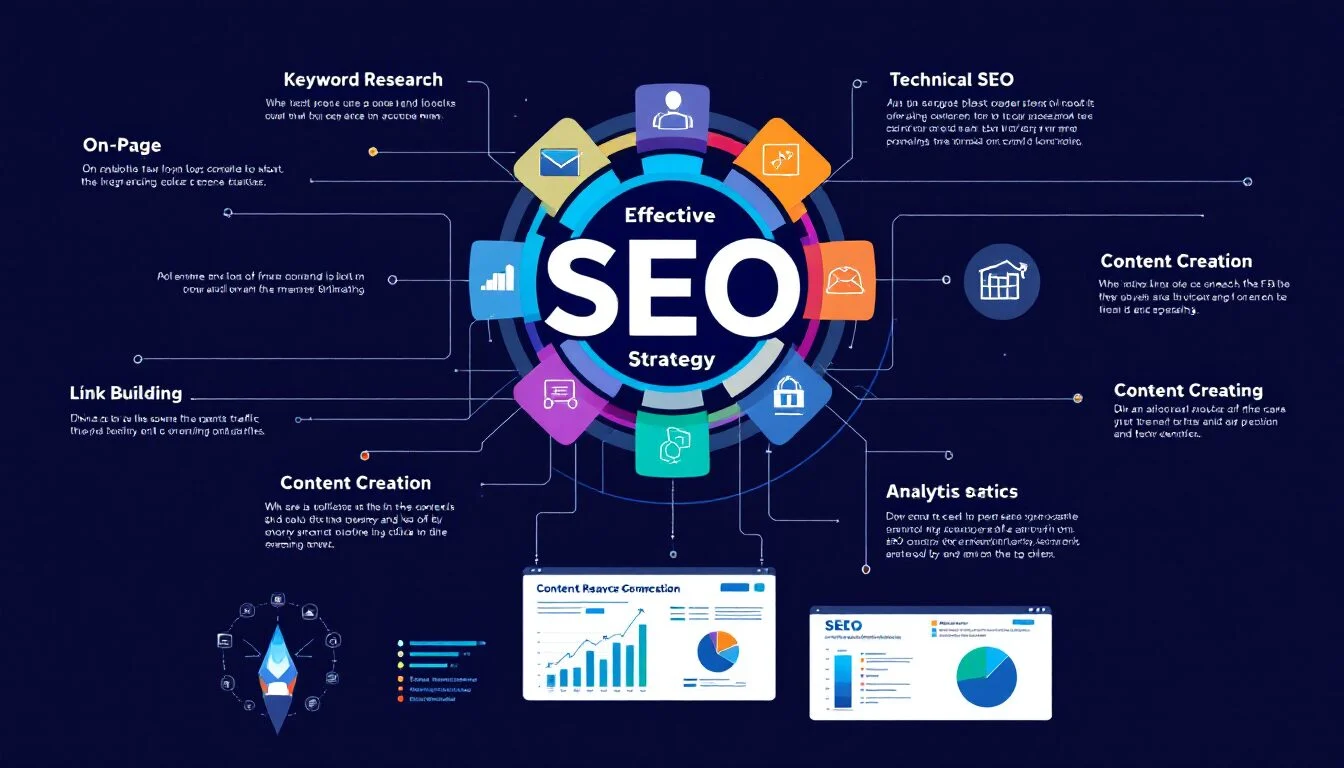In today’s digital landscape, visibility is everything. With millions of websites competing for attention, how does yours stand out in the crowd? Enter Search Engine Optimization (SEO) – the powerful strategy that has transformed from simple keyword stuffing in the mid-1990s to a sophisticated discipline that can make or break your online presence. Whether you’re a business owner watching competitors outrank you on Google or a marketing professional looking to enhance your digital strategy, understanding SEO isn’t just beneficial—it’s essential for survival in the digital ecosystem.
The mysterious algorithms that power search engines like Google determine which websites deserve the spotlight and which remain hidden in the shadows of page 10 (where virtually no one ventures). But here’s the reality: while 75% of users never scroll past the first page of search results, many businesses continue to invest thousands in beautiful websites that nobody finds. 🔍 SEO bridges this gap by working through three core pillars: Technical Optimization to enhance your website’s infrastructure, On-Page Optimization to ensure content relevance, and Off-Page Optimization to build your site’s reputation through backlinks. Unlike paid advertising that stops delivering the moment you stop paying, effective SEO can provide lasting organic visibility and higher-quality traffic that converts into meaningful actions.
Throughout this comprehensive guide, we’ll demystify the fundamentals of SEO and explore how search engines actually work. We’ll trace the evolution of SEO practices from basic keyword manipulation to today’s sophisticated content strategies that satisfy both algorithms and human readers. You’ll discover the key components of an effective SEO strategy, understand how it complements Search Engine Marketing (SEM), and learn how to measure your SEO success with powerful tools like Google Analytics and Search Console. We’ll also explore the exciting career opportunities in this field and peek into the future of SEO in an increasingly AI-driven digital world. Ready to transform your approach to online visibility? Let’s dive in.
What is SEO: Understanding the Fundamentals
A. Definition of SEO and its importance for website visibility
Ever wonder why some websites pop up first when you search for something online, while others are buried on page 10? That’s SEO at work.
SEO (Search Engine Optimization) is the practice of optimizing your website to increase its visibility when people search for products or services related to your business on Google, Bing, and other search engines. The better visibility your pages have in search results, the more likely you are to grab attention and attract prospective and existing customers to your business.
Think of the internet as a massive library with billions of books. Without a proper organization system, finding what you need would be impossible. Search engines are the librarians, and SEO helps you make sure your book stands out on the front display instead of being tucked away in some dusty corner.
Why does this matter? Because 68% of online experiences begin with a search engine, and 53% of all website traffic comes from organic search. If you’re not visible in search results, you’re missing out on massive traffic, leads, and revenue opportunities.
And here’s the kicker – 75% of users never scroll past the first page of search results. If you’re not in those top spots, you might as well be invisible.
B. Difference between organic search and paid search
When you’re looking at a search results page, you’re actually seeing two different types of results: organic and paid. And yeah, there’s a huge difference between them.
Organic search results are the listings that appear because they’re relevant to someone’s search terms. These are the results that have earned their positions through effective SEO practices – not because someone paid for them to be there.
Paid search results, on the other hand, are advertisements. Businesses pay to have their listings shown when someone searches for specific keywords. These are typically labeled as “Ad” or “Sponsored” and often appear at the top or bottom of search results pages.
Here’s how they stack up against each other:
| Feature | Organic Search | Paid Search |
|---|---|---|
| Cost | Free (except for SEO work) | Pay-per-click (PPC) |
| Time to see results | Months (long-term) | Immediate (short-term) |
| User trust | Higher (70% click on organic) | Lower (only 30% click on ads) |
| Longevity | Results last longer | Stops when you stop paying |
| ROI | Higher in the long run | Can be costly with competitive keywords |
Most successful digital marketing strategies use both organic and paid search. They complement each other perfectly – paid search gives you immediate visibility while your SEO efforts build up over time.
C. Three core pillars: Technical, On-Page, and Off-Page Optimization
SEO isn’t just one thing – it’s a three-headed beast. To tame it, you need to understand each head: technical, on-page, and off-page optimization.
Technical SEO focuses on how well search engines can crawl and index your site. It’s like making sure all the doors and hallways in your house are accessible so visitors can see everything you have to offer. This includes:
- Site speed (because nobody waits more than 3 seconds for a page to load)
- Mobile-friendliness (over 60% of searches now happen on mobile devices)
- Secure connections (HTTPS)
- Clean URL structures
- XML sitemaps
- Proper robots.txt files
On-page SEO is about optimizing individual pages to rank higher and earn more relevant traffic. This is where content quality really shines. Key elements include:
- High-quality, valuable content that answers users’ questions
- Strategic keyword placement (without keyword stuffing)
- Optimized title tags and meta descriptions
- Header tags (H1, H2, H3, etc.)
- Internal linking structure
- Image optimization with alt tags
Off-page SEO refers to actions taken outside of your website to impact your rankings. Think of it as your site’s reputation in the digital world. This primarily involves:
- Backlinks from reputable websites (still one of the strongest ranking factors)
- Social media signals
- Brand mentions
- Local SEO activities (Google My Business, reviews, citations)
All three pillars need to work together – ignore any one of them, and your SEO strategy will collapse like a two-legged stool. The most successful websites maintain a healthy balance between all three types of optimization.
How Search Engines Work
The crawling, indexing, and ranking processes
Ever wondered how Google seems to know everything on the internet? It’s not magic—it’s a three-step process that happens constantly.
First, search engines send out little digital robots (called “crawlers” or “spiders”) that zip around the web following links. Think of them as tireless librarians scanning every page they can find. They don’t read like humans do—they’re analyzing code, checking links, and taking snapshots of content.
After crawling, search engines organize everything they’ve found into a massive index. This is like creating the world’s biggest filing system. When you type a query, they’re not searching the live internet—they’re searching this index.
The final piece is where things get interesting: ranking. This is when search engines decide which pages deserve to be on top for your specific search. They consider hundreds of factors:
- Is the content relevant?
- Is the website trustworthy?
- Does it load quickly?
- Is it mobile-friendly?
- Do other reputable sites link to it?
The whole process happens in milliseconds. Pretty mind-blowing when you think about it.
Google’s algorithms: RankBrain, Panda, Penguin, Hummingbird, and BERT
Google doesn’t reveal exactly how its search magic works, but we know it relies on several key algorithms that have transformed search over the years.
Panda (2011) was Google’s first big quality crackdown. It targeted low-quality content and content farms, essentially saying “enough with the garbage.” Websites with thin content or keyword stuffing took major hits.
Penguin (2012) focused on sketchy backlink practices. Buying links or participating in link schemes? Penguin was designed to catch you.
Hummingbird (2013) was a complete engine overhaul. Instead of just matching keywords, Google started understanding the meaning behind searches. It was their first big step toward semantic search.
RankBrain (2015) brought machine learning into the mix. It helps Google interpret never-before-seen searches (which happen millions of times daily) and match them with relevant results.
BERT (2019) is Google’s natural language processing breakthrough. It understands context and nuance in search queries like never before. It gets the difference between “can you get medicine for someone pharmacy” and “can someone get my medicine from the pharmacy.”
Each update shares a common goal: delivering exactly what you’re looking for, not just what matches your keywords.
How search engines determine relevance and user satisfaction
Search engines have one job: giving people exactly what they’re looking for. But how do they know what’s relevant?
They look at obvious signals first—do the keywords match? Does the page actually discuss the topic? But they go way deeper than that.
Content quality matters enormously. Search engines analyze everything from reading level to content depth. They can tell the difference between a quick, shallow article and an in-depth resource.
User behavior tells them a lot too. If people click on your link but immediately bounce back to search results (the “pogo stick” effect), that’s a red flag. But if they stay on your page, maybe even visit other pages on your site? That signals satisfaction.
Site structure and technical factors play a huge role. Is your site organized logically? Does it load fast? Work well on mobile? These all impact how search engines view your content.
Backlinks still matter tremendously. When authoritative sites link to yours, search engines see it as a vote of confidence.
The fascinating part? These systems continuously learn and adapt. Every search query helps train the algorithms to better understand what people want, creating a feedback loop that constantly improves results.
The Evolution of SEO
From keyword stuffing to quality content (1990s to present)
Remember when SEO was basically a game of “how many times can I cram my keyword into this page”? The early days of search were like the Wild West – no rules, just chaos.
Back in the ’90s, search engines were pretty dumb. They couldn’t tell the difference between valuable content and garbage stuffed with keywords. Websites ranked high by simply repeating phrases like “best shoes” fifty times at the bottom of the page – often in invisible text or hidden in the metadata.
Then came the reality check.
Google showed up in 1998 with a revolutionary idea: what if search results were ranked by how many other sites linked to them? This PageRank system changed everything. Suddenly, it wasn’t just about keywords – it was about who vouched for your content.
By the mid-2000s, the race was on. SEO “professionals” found new loopholes: buying links, creating link farms, and spinning articles into unreadable gibberish just to create more pages.
Google’s response? A series of increasingly sophisticated updates that prioritized actual human readers over algorithms.
The shift has been dramatic:
| Era | SEO Focus | Effectiveness Today |
|---|---|---|
| 1990s | Keyword density, meta tags | Almost useless |
| Early 2000s | Backlink quantity | Counterproductive |
| 2010s | Content relevance, user experience | Highly effective |
| 2020s | Helpful content, user intent | Essential |
Today’s SEO is about answering real questions from real people. Quality trumps quantity every time.
Major algorithm updates and their impact on SEO practices
Google doesn’t announce most of its algorithm tweaks – they make thousands yearly. But when they roll out a major update, the SEO world feels the earthquake.
Remember Panda in 2011? It crushed sites with thin content and keyword stuffing. Overnight, content farms lost 80% of their traffic. Businesses that had been gaming the system suddenly found themselves invisible.
Then Penguin swooped in (2012) targeting spammy backlink practices. Sites that bought links or used link schemes plummeted in rankings.
But the update that really changed the game was Hummingbird (2013). It wasn’t about punishing bad behavior – it completely rewired how Google understood searches. Suddenly, Google could grasp the meaning behind queries, not just match keywords.
Here’s how these major updates transformed SEO practices:
- Panda: Content creators had to focus on original, valuable information instead of thin, duplicate content
- Penguin: Link building became about quality, relevance and natural acquisition
- Hummingbird: Keyword research expanded to include topics, questions, and related concepts
- RankBrain (2015): SEOs needed to optimize for user intent and satisfaction, not just keywords
- BERT (2019): Content had to be conversational and naturally written to match how people actually talk
- Helpful Content Update (2022): Sites needed to demonstrate genuine expertise and value
Each update pushed SEO professionals to think less about gaming algorithms and more about serving users. The days of quick tricks are over – today’s SEO success requires actual value.
Current emphasis on user intent and helpful content
Gone are the days when SEO was a technical game separate from content quality. Google’s gotten scary good at figuring out what people actually want when they search.
User intent is everything now.
Think about it – when someone types “apple” into Google, what do they want? Information about the fruit? Details on the tech company? Help with their iPhone? Google’s algorithms work overtime trying to decode what’s actually going on in the searcher’s head.
This is why keyword research has evolved from “find exact match phrases” to “understand the questions behind the search.” Modern SEO pros are almost like psychologists, mapping out user journeys and pain points.
The concept of “helpful content” has taken center stage. Google doesn’t just want relevant content – they want content that genuinely solves problems and answers questions. Their systems are increasingly able to measure if visitors found what they needed or bounced back to search results unsatisfied.
What this means for websites:
- Comprehensive coverage of topics beats keyword-focused pages
- Actual expertise matters more than ever (Google’s E-E-A-T guidelines)
- User experience metrics (time on page, bounce rate) influence rankings
- Content structure should match how humans consume information
- Different search intents require different content formats
The websites crushing it with SEO today don’t obsess over rankings as the end goal. They focus on being genuinely helpful to their visitors, understanding that rankings follow when you solve real problems for real people.
Key Components of an Effective SEO Strategy
A. Setting realistic objectives aligned with business goals
Ever notice how some businesses crush their SEO while others spin their wheels for years? The difference often comes down to one thing: clear objectives that actually connect to business outcomes.
Don’t just say “I want to rank #1 for [keyword].” That’s like saying you want to be famous without knowing what for. Instead, ask yourself what business problem you’re solving with SEO:
- Are you trying to increase qualified leads by 20%?
- Do you need to reduce customer acquisition costs?
- Looking to break into a new market segment?
Your SEO goals should directly support these business objectives. If they don’t, you’re just chasing vanity metrics.
Start by auditing where you are today. What’s your current organic traffic? Conversion rate? Revenue from organic search? Without baseline data, you’ll never know if your SEO is actually working.
Then set SMART goals:
- Specific: “Increase organic traffic to product pages by 30%”
- Measurable: Track with Google Analytics and Search Console
- Achievable: Based on your resources and competition
- Relevant: Tied to actual business outcomes
- Time-bound: “Within the next 6 months”
B. Technical optimization for improved website infrastructure
Technical SEO isn’t sexy, but it’s the foundation everything else sits on. Skip it, and you’re building on quicksand.
The technical side of SEO breaks down into a few critical areas:
Site speed matters more than ever. Google’s Core Web Vitals are now ranking signals. When pages take more than 3 seconds to load, 53% of mobile visitors bounce. That’s half your potential customers gone before they even see what you offer.
Mobile-friendliness isn’t optional anymore. Google indexes the mobile version of your site first. Period. If your site looks janky on phones, you’re already losing.
Crawlability is about making it easy for search engines to find and understand your content. This means:
- A logical site structure
- Clean, descriptive URLs
- Proper internal linking
- An accurate sitemap.xml
- A sensible robots.txt file
Schema markup helps search engines understand what your content means, not just what it says. This structured data can score you rich snippets in search results, which typically boost click-through rates by 30% or more.
The best part? Most technical SEO issues can be identified with tools like Screaming Frog, Semrush, or even Google’s free tools. Fix these fundamentals first before worrying about advanced tactics.
C. Content creation that serves both users and search engines
Content is still king, but not just any content will do. The days of keyword-stuffed garbage are long gone.
What works now is content that actually solves problems for real humans while giving search engines the signals they need. It’s a balancing act, for sure.
Start with search intent. When someone types a query, what are they actually looking for? There are four main types:
- Informational (“how to fix a leaky faucet”)
- Navigational (“facebook login”)
- Commercial (“best running shoes 2025”)
- Transactional (“buy Nike Air Zoom”)
Your content needs to match the intent behind the keywords you’re targeting. Get this wrong, and you’ll never rank, no matter how “optimized” your content is.
Once you understand intent, create content that’s:
- Comprehensive enough to fully answer the query
- Structured logically with proper heading hierarchy
- Easy to scan with bullet points and short paragraphs
- Enhanced with relevant visuals, videos, or tools
- Written in language your audience actually uses
Then optimize for search engines by:
- Including your primary keyword in the title, H1, and first paragraph
- Using related terms naturally throughout
- Adding internal links to other relevant pages
- Optimizing meta descriptions to improve click-through rates
The best SEO content doesn’t feel optimized at all. It just feels helpful.
D. Building site reputation through quality backlinks
Backlinks remain one of Google’s strongest ranking factors, but the game has changed dramatically. Today, it’s quality over quantity, every time.
One high-authority, relevant link can outweigh hundreds of spammy ones. In fact, those spammy links might actually hurt you now.
The best backlinks come from:
- Trusted industry publications
- Relevant blogs in your niche
- Educational institutions (.edu domains)
- Government sites (.gov domains)
- Major news outlets
How do you get these coveted links? Through methods that actually provide value:
Original research gets linked. Conduct surveys, analyze data, or create industry benchmarks that others will reference.
Create linkable assets like tools, templates, or comprehensive guides that serve as resources people naturally want to share.
Build relationships with journalists, bloggers, and influencers in your industry. Help them first, without expecting immediate returns.
Guest posting still works when done selectively on quality sites relevant to your industry (not random link farms).
Remember, link building takes time. It’s about gradually building your site’s authority and reputation. There are no shortcuts that don’t eventually backfire.
The most effective link building strategies are those that would make sense even if SEO didn’t exist – they’re about creating genuine value and building real relationships.
SEO and SEM: A Complementary Approach
Understanding Search Engine Marketing (SEM)
Think of SEO as the slow-and-steady marathon runner, while SEM is the sprinter who gets you immediate results.
Search Engine Marketing (SEM) primarily involves paid advertising on search engines. Unlike SEO, which focuses on organic visibility, SEM gets you right to the top of search results—those spots marked “Ad” that you see before the organic listings.
The core of SEM is pay-per-click (PPC) advertising, where you bid on keywords relevant to your business. When someone searches using those keywords, your ad appears, and you only pay when someone actually clicks on it. Pretty neat, right?
Key components of SEM include:
- Google Ads (formerly AdWords): The biggest player in the PPC space
- Bing Ads: Microsoft’s alternative with different audience demographics
- Ad copy creation: Crafting compelling headlines and descriptions
- Landing page optimization: Making sure visitors convert once they click
- Bid management: Strategically adjusting how much you pay per click
The beauty of SEM? It’s incredibly measurable. You can track every dollar spent and see exactly what return you’re getting.
When to use SEO vs. SEM for maximum impact
SEO and SEM aren’t competing strategies—they’re different tools for different situations. Here’s when to lean on each:
Choose SEO when:
- You’re building for the long term
- You have limited budget but more time
- Your content naturally matches what people search for
- You want to establish authority in your industry
- You’re targeting informational queries like “how to” questions
Choose SEM when:
- You need immediate visibility
- You’re launching something new (product, service, website)
- You’re targeting highly competitive keywords
- You’re running time-sensitive promotions
- You want to target specific geographic locations with precision
- You’re focused on commercial-intent searches (people ready to buy)
The smart move? Don’t think of it as an either/or decision. Your strategy should consider both, with the balance shifting based on your current goals, timeline, and budget.
Integrating both strategies for comprehensive search visibility
The magic happens when SEO and SEM work together. They’re like peanut butter and jelly—good separately, amazing together.
Here’s how to make them play nice:
- Share keyword intelligenceWhat performs well in your PPC campaigns often makes great SEO targets, and vice versa. Let each strategy inform the other.
- Dominate the SERPWhen you rank organically AND have a paid ad for the same search, you essentially double your real estate on the results page. Studies show this can significantly increase overall click-through rates.
- Use SEM to test, SEO to capitalizeTest new keywords with SEM to quickly see which convert best, then focus your longer-term SEO efforts on those winners.
- Balance your budgets seasonallyDuring peak seasons, ramp up SEM for immediate traffic. During slower periods, invest more in SEO to build long-term value.
- Create a consistent messageEnsure your ad copy and organic meta descriptions tell a cohesive story about your brand.
A well-executed combined strategy creates a “halo effect” where your brand appears more credible because you’re visible in multiple places. This comprehensive approach maximizes visibility throughout the entire customer journey—from initial research (often dominated by organic results) to final purchase decisions (where ads can provide that final push).
Measuring SEO Success
Essential SEO tools: Google Search Console and Google Analytics
Ever wonder if your SEO efforts are actually working? Stop guessing and start measuring.
Google Search Console is your eyes and ears for how Google sees your site. It shows you:
- Which search terms bring visitors to your site
- How many people click through from search results
- Which pages Google has indexed (and which ones it’s struggling with)
- Any technical issues that might be hurting your visibility
The best part? It’s completely free. Set it up today and you’ll kick yourself for not doing it sooner.
Google Analytics completes the picture by showing what happens after visitors land on your site:
- How long do they stick around?
- Which pages do they visit?
- Where do they drop off?
- Are they converting into customers or subscribers?
Together, these tools give you the complete journey from search to sale.
Key metrics to track and analyze
Not all metrics matter equally. Focus on these game-changers:
Organic traffic: The number of visitors coming from search engines. This is your bottom-line SEO metric.
Conversion rate: Traffic means nothing if nobody’s buying. Track how many searchers become customers.
Keyword rankings: Monitor positions for your target keywords, but don’t obsess over small fluctuations.
Click-through rate (CTR): If you’re ranking well but nobody’s clicking, your title tags and meta descriptions need work.
Bounce rate: High bounce rates often signal a mismatch between what searchers want and what your page delivers.
Page load speed: Slow sites kill conversions. Period.
Continuous adaptation and improvement based on data
SEO isn’t a “set it and forget it” game. The real pros are constantly tweaking based on data.
Start with a monthly review cycle:
- Identify underperforming pages with high potential
- Spot keywords where you’re ranking on page two (these are gold mines!)
- Update old content that’s losing traffic
- Fix technical issues flagged in Search Console
When you see significant changes (good or bad), dig deeper. Maybe that content update worked wonders, or perhaps that new site design tanked your mobile rankings.
Test, measure, adjust, repeat. That’s how the SEO game is won.
Remember that search engines and user behaviors change constantly. What worked last year might not work today. Stay curious and keep learning from your data.
SEO Skills and Career Opportunities
Essential skills for SEO specialists
Want to break into the world of SEO? You’ll need more than just knowing what SEO stands for. The most successful specialists blend technical knowledge with creative thinking.
First up, analytical skills are non-negotiable. You’ll spend hours digging through data, spotting trends, and making decisions based on what you find. If spreadsheets make you happy, you’re off to a good start.
Technical SEO knowledge is your foundation. This includes understanding how search engines crawl websites, how to optimize site structure, and fixing technical issues that might be holding rankings back.
Content creation skills set the great SEO pros apart from the good ones. You need to know what makes content rank, but also what makes people actually want to read it.
Communication is huge too. You’ll need to explain complex SEO concepts to clients or team members who might not know their robots.txt from their 301 redirects.
Other must-have skills include:
- Keyword research expertise
- Link building strategies
- Basic HTML and CSS knowledge
- UX/UI understanding
- Familiarity with SEO tools like Ahrefs, SEMrush, or Screaming Frog
Potential earnings and career paths
The money in SEO can be pretty sweet, especially as you climb the ladder. Entry-level specialists typically start around $45,000-$60,000 annually, but experienced SEO managers can easily pull in $80,000-$120,000+.
The career path usually looks something like this:
| Position | Experience Level | Typical Salary Range |
|---|---|---|
| SEO Specialist | 0-2 years | $45,000-$60,000 |
| SEO Analyst | 2-4 years | $60,000-$75,000 |
| SEO Manager | 4-7 years | $75,000-$100,000 |
| SEO Director | 7+ years | $100,000-$150,000+ |
But here’s the cool thing about SEO careers – they’re incredibly flexible. You could work in-house at a company, join an agency to work with multiple clients, or go freelance and be your own boss.
Many SEO pros also branch out into related fields like:
- Content marketing
- Digital marketing strategy
- Conversion rate optimization
- PPC advertising
- Social media marketing
Some even launch their own agencies after building up experience and a client base. The ceiling is pretty much nonexistent if you’re good at what you do.
Ongoing education and resources for SEO professionals
SEO changes faster than most professionals can keep up with. Google rolls out hundreds of algorithm updates yearly, with major ones completely shifting the landscape overnight.
Staying current isn’t optional – it’s survival.
The best SEO pros set aside dedicated time each week for learning. They’re constantly testing new strategies, reading industry blogs, and connecting with other experts.
Some essential learning resources include:
- Industry blogs: Search Engine Journal, Moz Blog, Ahrefs Blog, and Search Engine Land publish actionable content daily.
- Podcasts: SEO 101, Authority Hacker, and Search Engine Journal Show let you learn during commutes or workouts.
- YouTube channels: Ahrefs, Google Search Central, and Backlinko offer visual tutorials on everything from technical audits to content strategy.
- Communities: Reddit’s r/SEO, Facebook groups, and Twitter’s #SEO hashtag provide places to ask questions and share knowledge.
- Courses and certifications: Google’s own SEO fundamentals course, Moz Academy, and SEMrush Academy offer structured learning paths.
The true SEO experts don’t just consume content though – they experiment constantly. They test theories on their own sites before implementing changes for clients or employers.
Remember: in SEO, what worked yesterday might not work tomorrow. The professionals who thrive are the ones who never stop learning.
The Future of SEO
The role of AI in search optimization
The SEO game is changing fast, and AI is the power player behind it all.
Google’s been using AI for years, with RankBrain and BERT algorithms becoming smarter at understanding what users actually want. But now? We’re in a whole new ball game.
AI doesn’t just understand content anymore—it creates it, optimizes it, and predicts what will rank well. Tools can now analyze top-performing content and suggest improvements before you even hit publish.
Voice search? That’s AI too. As more people ask Alexa and Siri questions, search is becoming conversational. Your content needs to answer questions naturally, not just stuff keywords everywhere.
The scary part? AI can actually predict algorithm changes. Some advanced SEO platforms now forecast ranking fluctuations before they happen, giving savvy marketers a serious edge.
But don’t panic—humans still matter. AI can’t replace genuine expertise or create truly original insights. The winning formula is using AI tools to handle the technical heavy lifting while you focus on creating content that actually connects with people.
Core Web Vitals and user experience as ranking factors
Google doesn’t care about your keyword density anymore. They care if people enjoy using your site.
Core Web Vitals have changed everything. These metrics measure loading performance (LCP), interactivity (FID), and visual stability (CLS). In plain English? How fast your page loads, how quickly it responds, and whether stuff jumps around while loading.
| Core Web Vital | What It Measures | What Users Want |
|---|---|---|
| LCP | Loading speed | Under 2.5 seconds |
| FID | Interactivity | Under 100ms |
| CLS | Visual stability | Under 0.1 |
But it goes beyond these technical measures. Google now factors in whether people bounce quickly, how they interact with your content, and whether your page answers their questions.
Mobile experience isn’t optional anymore—it’s essential. With mobile-first indexing, Google primarily uses your mobile site for ranking, even for desktop searches.
Page experience signals like HTTPS security, safe browsing, no intrusive popups, and accessibility features all influence your rankings too.
The bottom line? Technical SEO and content quality are now inseparable. You need both to win.
Emerging trends and how to stay ahead in SEO
Want to know what’s around the corner? Here’s what’s already changing the SEO landscape:
Visual search is exploding. People are searching with images, not just words. Google Lens, Pinterest Lens, and other visual search tools mean you need to optimize images with proper alt text, descriptive filenames, and relevant context.
Zero-click searches are the new normal. Most Google searches now end without a click because users get answers directly in the SERPs. Featured snippets, knowledge panels, and PAA boxes are prime real estate you need to target.
E-A-T (Expertise, Authority, Trustworthiness) isn’t just a buzzword—it’s crucial for ranking. Google’s getting better at identifying truly authoritative content, especially for YMYL (Your Money Your Life) topics.
Local SEO is transforming with near-me searches, Google Business Profile optimization, and local service ads becoming more sophisticated.
To stay ahead:
- Follow the right people (not just any SEO blog)
- Test constantly instead of accepting “best practices”
- Analyze your own data rather than industry averages
- Join communities where cutting-edge tactics are shared
- Look beyond SEO—study UX, content strategy, and customer psychology
The SEO pros who thrive will be those who adapt fastest while keeping focused on what hasn’t changed—creating genuinely useful content for real people.
Conclusion
The Journey Through SEO Never Ends
As we’ve explored throughout this article, SEO is far more than just a set of technical practices—it’s a dynamic, evolving discipline that requires constant adaptation and learning. From understanding the fundamental mechanics of search engines to keeping pace with algorithm updates like Panda, Penguin, and BERT, successful SEO demands both technical expertise and creative content strategy. The three pillars of Technical, On-Page, and Off-Page optimization work together to create a comprehensive approach that can significantly impact your online visibility and business success.
Whether you’re looking to enhance your website’s performance, pursue a career in digital marketing, or simply understand why some content ranks higher than others, SEO knowledge is invaluable in today’s digital landscape. As AI continues to reshape search capabilities and user experience metrics like Core Web Vitals gain importance, staying informed through resources like Google Search Console, analytics platforms, and educational content will be crucial. Remember that at its core, effective SEO is about serving users with high-quality, relevant content—making it not just a marketing strategy, but a form of customer service that builds lasting relationships with your audience.









LATEST NEWS
📥 Δωρεάν PDF Οδηγός: Nano Banana Pro Prompts 2025/2026 (GR+EN)
MoreTo Google Maps αλλάζει: Η νέα τεχνολογία που αλλάζει για πάντα τον τρόπο που ταξιδεύουμε – Δείτε τι μπορεί να κάνει!
More7 Νέες Λειτουργίες του Google Nano Banana Pro που Πρέπει να Δοκιμάσεις
More